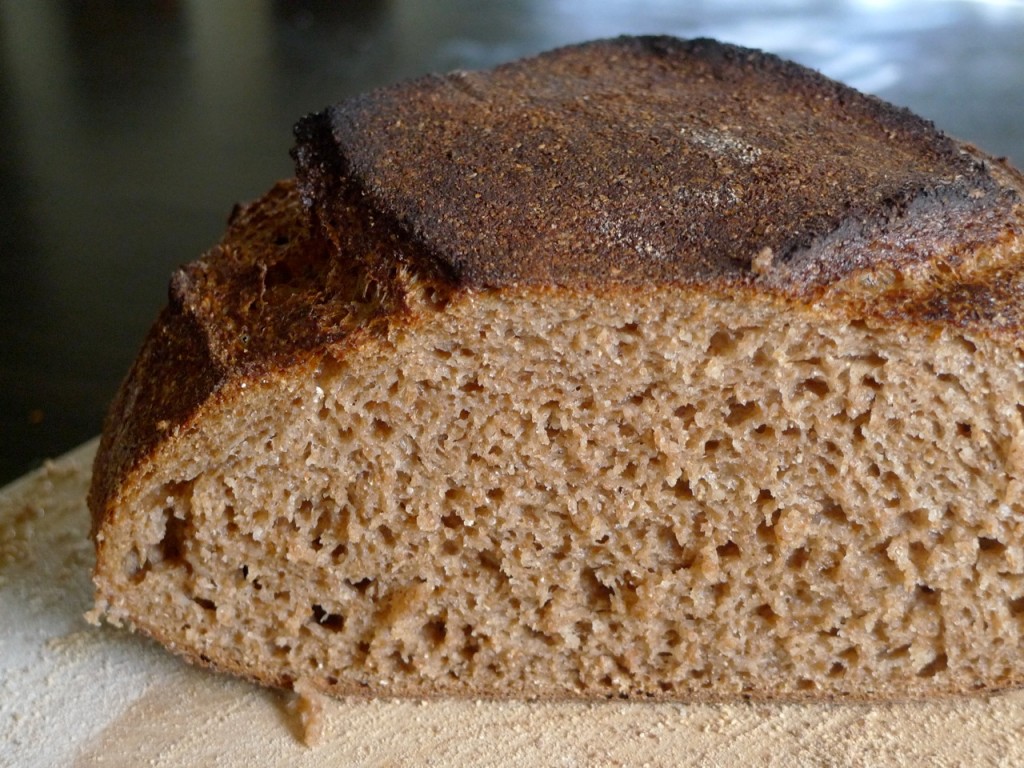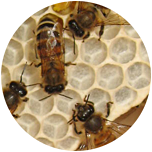 The slices of bread on my sandwich were not loaf-shaped, they were round—perfectly round—and it was bursting with alfalfa sprouts. Eaten by a young boy with long, wavy hair and often-repaired glasses, this circular sandwich was part of a pretty alien picture in my small-town elementary school.
The slices of bread on my sandwich were not loaf-shaped, they were round—perfectly round—and it was bursting with alfalfa sprouts. Eaten by a young boy with long, wavy hair and often-repaired glasses, this circular sandwich was part of a pretty alien picture in my small-town elementary school.
Mom was baking whole wheat breadWhole wheat bread was another highly unusual lunch food at that time. in large apple juice tins at that time, which made cylindrical loaves. I think my mother still worries about the many forms of trauma I suffered, but I feel reasonably well adjusted. It didn’t kill me, therefore…
I used a bread machine for a while. I made no-knead bread for a while. I never really got serious about regular bread, because all the kneading seemed like too much work.
But, recently Carmen has been feeling bloated after eating bread. Bread activist Andrew Whitely fingers modern additivesAnd modern wheat varieties. that allow very fast rising times for the recent increase in gluten intolerance and celiac disease.Can I say I just love it when people say dis-ease.
Bread made with all these enzymes and additives can go from a bag of flour to the back of a delivery truck in less than four hours, whereas bread that is traditionally leavened with sourdough can take a day or more. In that time, bacteria can make wheat proteins more digestible for many people.
This article about Whitely blew my mind, so I decided to try making sourdough bread. I have now made a loaf I consider good enough to post here. Like no-knead bread, this loaf requires a cast-iron dutch oven or combo cooker for baking. Or, as I use, a pyrex bowl with a glass lid.
We had eaten some very, very delicious bread, baked by Andrew Plotsky who made the very beautiful Anatomy of Thrift videos. Andrew said the book Tartine Bread was the oracle of wisdom, so I requested it from library. Since it was a bit of a wait I got busy on my sourdough starter.
Sourdough starter is another one of those things that has the ring of the impossible. It feels like only people who are much tougher and smarter—sharpshooters who know esoteric knots—could possibly make sourdough. My parents have a sourdoughOne of the many siblings of the Herman sourdough starter. and it requires feeding with all-purpose flour, sugar and milk—which seems terribly fussy and not conducive to the Small and Delicious Life. But, it turns out wheat is covered with bacteria, and sourdough grows itself. The process is easy, though, like most of my projects, it takes a little time at the right time.Somebody should come up with a name for that kind of work. I followed these instructions.And here are answers to your sourdough questions.
So, I have a nice starter, which I stabilized and now keep in the fridge. I feed it only whole wheat flour and water, and everything seems fine; if it dies, I will just make another one.
I did a bunch of research and really enjoyed Exorphin Junkie and the Northwest Sourdough Bakers Forum. Peter Reinhart’s Artisan Bread Every Day is also a lovely book with lots of ideas for shaping loaves, and slightly different information about what is going on in sourdough.
Finally, Chad Robertson’s Tartine Bread came from the library. It is indeed a fantastic book, full of romantic stories of bakeries in France and odes to sourdough. The many recipes for things to do with bread made me salivate. But it does not have a 100% whole wheat recipe. Exorphin Junkie suggests following the standard recipe but substituting whole wheat flour, so that is what I did—and then I spent a few weeks futzing around with how much water to add.
If you are serious about sourdough, I would suggest you read the book. But, Martha Stewart has a reasonable synopsis of the technique you can compare to my mongrelized methods. Make the sourdough as above, and start paying attention to Martha at Step 6.
As a side note, when I was a kid we had a flour mill, and to this day, I love the nutty flavour of pancakes made with freshly-ground wheat. Several years ago I found a used Mill-Rite to grind the British Columbia Hard Red WheatThere has been a Red Fife revival around here. I bought a small bag of it and will see how it goes after I bake through the five kilos of Red Spring I currently have. I get from our local bulk food store.If you are into bulk food—and I hope you are—may I introduce you to my fine design for a reusable, measuring, bulk food bag? The Mill-Rites are true grist mills famous for their slow grind—I think my millstones turn at 45 rpm. This keeps the flour cool during grinding, which, according to the internet wisdom, means nutrients are not destroyed by the heat of grinding.
Before I get to the recipe, I want to mention one more thing I learned—Baker’s Percentages, which make scaling recipes up or down quite easy. In this recipe method, the weight of the flour is always called 100% and everything else is relative to that; your recipe will total 190% or 220% or whatever. I will give both absolute weight and baker’s percentages here.
First, feed up your starter. I like to add 1/4 to 1/2 cup of flour and half that amount of water to my starter the night before, then leave it out on the counter overnight. I may change that slightly, because this beautiful loaf was made with starter that I fed in the morning and waited until it had risen—around noon—before I started the steps below.
100 grams starter
450 grams room temperature water
500 grams freshly ground hard red whole wheat flour
10 grams salt (2 tsp)
50 grams water (2 oz.)
or:
20% starter
90% water
100% WW flour
2% salt
10% water
Mix 100 grams of starter into 450 grams of water, then add 500 grams of flour. Combine until the flour is wetted, then cover and leave for 45 minutes to one hour.
Feed the started by adding 1/4 cup flour and 1/8 cup water, then put it back in the fridge.
After an hour, add 10 grams salt to 50 grams water and stir until dissolved. Add to the dough and squinch everything through your fingers until it is combined. Cover and let sit for 45 minutes to one hour.
Begin gentlyI say gently, because I think that may help the fragile bubbles in whole wheat bread. This forum advocates vigour. I’ll let you know how it goes after some experimentation. developing the dough by folding it every half hour. Wet your fingers and slide your hand under the dough, then lift it up, and let it stretch back down to the bowl.The pictures of dough in Tartine Bread look considerably wetter, which I imagine is because they are made using white flour. I tried using wetter dough, but prefer the loaf made with this percentage hydration. Please experiment. Turn the bowl 90 degrees and repeat twice more. Cover and let sit.
Repeat this stretching and folding every half hour for three or four hours.
Turn the dough out onto a cutting board and flour the top. Begin forming it into a ball, kind of rolling it on the board between your cupped hands while tucking the bottom under with your little fingers. You want the top of the ball to be smooth and tight, but not so tight it rips. Flour, cover with a teatowel, and let rest for 30 minutes.
Repeat. After the ball has rested again, line a bowl with the tea towel and flour the towel heavily. Use a dough scraper to make sure the ball is not stuck to the cutting board, then, using the scraper, lift the ball and place it upside down in the bowl. Flour the dough a bit more, then fold the towel over the top and put in the fridge overnight.
The next morning, pull the bowl out of the fridge and let it warm up for a couple of hours.Again, the internet is ablaze with controversy. Many people feel you do not need to let the ball warm up, just go straight from the fridge to the heated dutch oven. I will be trying this, but may need to let the dough rise in the fridge for another 6-10 hours. Preheat the oven and your dutch oven to 450°. When it is hot, flour the dutch oven and dump the dough into it, as gently as possible under the circumstances.
Using a razor blade, slash the top of the dough in a square. It is ideal if the blade is flat, so the cuts go in sideways, not down, but don’t burn yourself on your dutch oven.The cast iron combo cooker allows for easier slashing
Put the lid back on, and bake everything for 20 minutes. Then take the lid off and bake for 25 more minutes.Martha’s Tartine recipe says to preheat at 500° then turn the heat down to 450° for baking. I have been afraid of turning it up to 500° for fear my old glass bowl will explode like a grenade of sizzling glass
Cool on a rack and give it a bit of time before slicing.
So, this is not hard, and does not take a lot of time in total, but it does take a little time at the right time. This works for us right now, but may not always; Tartine Bread goes into some detail about how to shift the schedule of the bread to suit your timeline.
This bread—100% whole wheat leavened with sourdough—is what I call Next Level Shit. Just as with making fermented and dried Salami Milano, and Parmesan cheese, this bread feels like a major accomplishment. It is delicious and moist, not at all dense, and just as Chad Robertson promises, it keeps very well. It will sit for a week on the countertop without going mouldy. And, Carmen feels good after eating it.
UPDATE:
 Every loaf I have made since gets better, and this loaf is the best, with delightful ears and a nice holiness. It was made with BC Red Fife wheat, Red Fife is a heritage variety that dominated Canadian grain farming until 1900. It was crossed to produce Marquis, another famous heritage grain. and took almost two days from feeding the starter to baking—again, just a little time, at the right time. I fed the starter at night and kept it in the fridge, then mixed the dough about noon the next day. I developed the dough all day, then let it rise in the fridge overnight. I took it out about noon the next day and let it rise until dinner, when I baked it off to accompany a delightful chicken-rice soup.
Every loaf I have made since gets better, and this loaf is the best, with delightful ears and a nice holiness. It was made with BC Red Fife wheat, Red Fife is a heritage variety that dominated Canadian grain farming until 1900. It was crossed to produce Marquis, another famous heritage grain. and took almost two days from feeding the starter to baking—again, just a little time, at the right time. I fed the starter at night and kept it in the fridge, then mixed the dough about noon the next day. I developed the dough all day, then let it rise in the fridge overnight. I took it out about noon the next day and let it rise until dinner, when I baked it off to accompany a delightful chicken-rice soup.
Changing to Red Fife left me with a very wet dough, so I added a little more flour in the development folds, but fortunately I had recently watched this video on high-hydration doughs.
I also enjoyed this video on developing the gluten sheath outside dough balls.And this video on shaping sourdough into various traditional shapes. There is so much to learn for the Small and Delicious Life, so much knowledge we have lost—knowledge that used to be as water to fish.
Miscellaneous trivia about the Ten Percent World:
My dear friend J.B. MacKinnon is officially on his book tour for The Once and Future World.
I encourage you—I insist—to buy many copies for holiday gifts. Write the Colbert Report and ask to have him on as a guest. But mostly you should read it and love it.
I will link to some reviews to do greater justice, but I want to talk about the 10% world and wheat. James coined the phrase to describe how much of nature we have left—even in the most wild and abundant places there is only about 10% of the historic abundance. He prescribes we remember, reconnect and rewild.
As always, James sees things more from nature, and I see things more from craft; we are always trying to peer into the mysterious and wonderful world the other inhabits. And here, I am gleefully appropriating his phrase for craft.
While traveling this summer, we spent a very lovely few days outside Amsterdam in a town called Laren.Fun fact: there is no asphalt in Laren. Every street I saw was surfaced with brick. Laren has many, many houses with thatched roofs. They are more expensive upfront, but also the most durable, and are very insulating. And insanely beautiful.
 But, I learned the modern wheat varieties, which are bred to have short stalks so as to devote more energy to the grain rather than the stem, are no good for thatching—the Dutch must now import wheat straw for their thatching.
But, I learned the modern wheat varieties, which are bred to have short stalks so as to devote more energy to the grain rather than the stem, are no good for thatching—the Dutch must now import wheat straw for their thatching.
So, a beautiful ecosystem of food and shelter, recycling, manual skills of field and home has been disrupted by the drive for better yield and higher profits by agribusiness. A 10% world indeed.
Review of The Once and Future World in the Chicago Tribune
Review of The Once and Future World in Harper’s Online
Review of The Once and Future World in the Globe and Mail
Review of The Once and Future World in the National Post
Great quote from the National Post interview: “Nature may not be what it was,” he writes, “but it isn’t simply gone. It’s waiting.”

[…] Fermentation converts the carbs in wheat to acid and gas, which gives you the sour in sourdough and the bubbles that leaven the bread. Predigesting the carbs is why many gluten-sensitive people can eat sourdough. […]
[…] of bread, I mentioned in My Best Loaf Yet that sourdough may be good for people with gluten sensitivity, and…here is a […]
[…] My best loaf yet. […]
Hello Ruben:
I recognize your mum’s bread recipe! I never made that bread in juice cans however as I only ever needed two loaf pans. The recipes in the Laurel’s Kitchen cookbook stand the test of time. I look forward to reading more of your writing.
Best,
Miranda
[…] My best loaf yet. […]
Looks good! You make me want to haul out the sourdough cookbook I got years ago, along with some dried culture that has been sitting in the fridge all this time. At the time I didn’t quite have the energy to proceed. Later it turned out there was a valid reason for that, never mind now.